
1/2
Parish church Salorno
Salorno/Salurn, Alto Adige Wine Road
| Jižní Tyrolsko vinicemi je bohaté na kulturu a historii, které stojí za objevení. |

1/2
Salorno/Salurn, Alto Adige Wine Road

Ora/Auer, Auer/Ora, Alto Adige Wine Road

S. Antonio-Pozzo/St. Anton-Pfuss, Kaltern an der Weinstraße/Caldaro sulla Strada del Vino, Alto Adige Wine Road

1/2
Tramin an der Weinstraße/Termeno sulla Strada del Vino, Alto Adige Wine Road

Laghetti/Laag, Salorno/Salurn, Alto Adige Wine Road

Ora/Auer, Auer/Ora, Alto Adige Wine Road

1/6
S. Giuseppe al Lago/St. Josef am See, Kaltern an der Weinstraße/Caldaro sulla Strada del Vino, Alto Adige Wine Road

Salorno/Salurn, Alto Adige Wine Road

Salorno/Salurn, Alto Adige Wine Road

Salorno/Salurn, Alto Adige Wine Road

1/3
Pinzano/Pinzon, Montan/Montagna, Alto Adige Wine Road

Caldaro Paese/Kaltern Dorf, Kaltern an der Weinstraße/Caldaro sulla Strada del Vino, Alto Adige Wine Road

S. Giuseppe al Lago/St. Josef am See, Kaltern an der Weinstraße/Caldaro sulla Strada del Vino, Alto Adige Wine Road

Magrè s.S.d.V./Margreid a.d.W., Margreid an der Weinstraße/Magrè sulla Strada del Vino, Alto Adige Wine Road

Monticolo/Montiggl, Eppan an der Weinstaße/Appiano sulla Strada del Vino, Alto Adige Wine Road

1/3
Pinzano/Pinzon, Auer/Ora, Alto Adige Wine Road

1/4
Salorno/Salurn, Alto Adige Wine Road

1/4
Tramin an der Weinstraße/Termeno sulla Strada del Vino, Alto Adige Wine Road

Laghetti/Laag, Salorno/Salurn, Alto Adige Wine Road

1/4
Predonico/Perdonig, Eppan an der Weinstaße/Appiano sulla Strada del Vino, Alto Adige Wine Road

Caldaro Paese/Kaltern Dorf, Kaltern an der Weinstraße/Caldaro sulla Strada del Vino, Alto Adige Wine Road

Egna/Neumarkt, Neumarkt/Egna, Alto Adige Wine Road

Andriano/Andrian, Andrian/Andriano, Alto Adige Wine Road

Ora/Auer, Auer/Ora, Alto Adige Wine Road

Cortaccia s.S.d.V./Kurtatsch, Kurtatsch an der Weinstraße/Cortaccia sulla Strada del Vino, Alto Adige Wine Road

Missiano/Missian, Eppan an der Weinstaße/Appiano sulla Strada del Vino, Alto Adige Wine Road

Mazzon/Mazon, Neumarkt/Egna, Alto Adige Wine Road

Ora/Auer, Auer/Ora, Alto Adige Wine Road

Favogna di Sotto/Unterfennberg, Margreid an der Weinstraße/Magrè sulla Strada del Vino, Alto Adige Wine Road

Egna/Neumarkt, Neumarkt/Egna, Alto Adige Wine Road